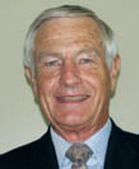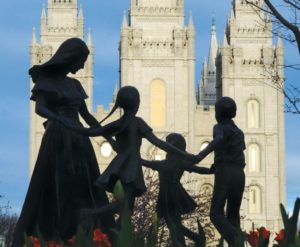Gathered on the campus of Brigham Young University, we were engaged in a day-long dialogue. Through the large windows inside the alumni and visitor center, a lofty view of the Wasatch Range lifted our minds and spirits toward the day’s topic: God—God as being both three and one.
At one point in the interfaith interaction, one participant began to recount her life experiences in coming to know God. She talked fondly of relating to God as her Father in Heaven, a key influence coming through her biological father’s calling his family to prayer each morning. She spoke of a grace-filled relationship with Jesus, much as she has done in previous dialogues. And she became most intense when describing her feelings of the Holy Spirit’s presence within her at baptism.
That God is three was obvious to her. But his oneness was equally evident. The Holy Spirit’s primary role has been a pointing her to Jesus; she noted how, in John 15, Jesus said it would be that way. Jesus, in turn, had opened the way for her to trust and adore the Father. In meaningful meditation, she said, her distinct images of three became mostly “meshed” in one—a “lived trinitarianism.” Though humbly aware of her limits—“so much about God I do not know”—she heartily affirmed: “But I do know him and know he knows me.”
 A Disjuncture
A Disjuncture
Testimony-type accounts like this provide a unique dimension and dilemma for Mormon-Evangelical dialogue. In the case above, we had spent most of the day discussing doctrinal developments of the fourth century, much of it focused on theology expressed in the Nicene Creed, which has become a standard of trinitarian faith for most Christian traditions, but for Latter-day Saints an unacceptable statement of who God is. In fact, in exploring some of the classical philosophical views that undergird our differences on this, one participant noted it’s “like comparison of apples and oranges.”
Yet when it comes to hearing one another describe our lived experiences of knowing the God who has revealed himself as Father, Son, and Holy Spirit, the contrast quickly shrinks. I dare say that all of us, several Evangelicals and several Mormons, resonated with or at least embraced this lady’s experience of God. Change a few idioms, leave out certain details about her baptism, limit Scripture quotes to the Bible, and it would be difficult to discern her identity as Mormon or Evangelical.
Dealing with this disjuncture is what for me has made dialoguing with Latter-day Saints both fascinating and challenging. What am I to say when doctrines diverge, but experiences appear to converge? How am I to relate when shared testimonies cultivate closeness, but shared theologies indicate distance? How am I to think when the praxis that should be informed by theory, seems to contradict it?
Attempted Explanations
I have heard (and given) various explanations attempting to resolve this tension. The following are given from an Evangelical viewpoint, but Mormon counterparts are surely available. I have witnessed a similar explanation-demanding bewilderment among them when from my testimony they sense I have had “promptings of the Spirit” that I am not supposed to have apart from believing their teaching and receiving their ordinances.
“This has to be a select group of Latter-day Saints with whom you are dialoguing. This woman’s testimony is not at all typical for Mormons,” might be one explanation, and probably not without some truth. All the Mormon participants at this dialogue were professional teachers. However, they are among the more influential leaders in the LDS Church Education System. The woman noted above is presently department chair for the Ancient Scripture Department at BYU and her books have been bestsellers at her church’s publishing agency, Deseret Book. She and another member of our group are among four authors of a book about Mormon teaching whose publication coincides (not by mere coincidence) with a decision to terminate printing a previous single-volume work that for decades had functioned as the standard on Mormon Doctrine (its title) to many. If space allowed, I would list credentials of other Mormons in the group, many of which put them also in a position of influence. One evening LDS ecclesiastical leaders, known as General Authorities, attended and encouraged our dialogues.
Furthermore, while this group may be select, their accounts of encountering God as both three and one are not exclusive. Currently, I also participate in another group in which a half dozen Evangelical clergy engage in Bible study with a half dozen instructors at an LDS Institute where LDS university students come to socialize and learn. Here again I am challenged by how honest discussions of doctrinal differences often end up being interwoven with common experiences in how we relate to Christ as the Savior from sin and the Lord we follow.
To these two groups I could add one-on-one interactions with Mormons in which the same disjuncture between theology and testimony emerges. I think of extended conversations with a retired school principal, a carpenter remodeling in our kitchen, or the friend presently serving as LDS Church Historian. I remember a philosophy professor (a Harvard Divinity School PhD who studied with Tillich and Stendahl) describing his encounter with Christ in a Mormon communion sacrament, and a Relief Society President (women’s group in a local congregation) narrating hers in the temple endowment ceremony while on a pre-dedication tour of a new temple.
To be sure, I have heard many testimonies from Latter-day Saints, with which I did not resonate at all. The same could be said, however, about many coming from Evangelical church members. “Religious experiences are for the most part feelings, highly subjective, not reliable,” is another Evangelical response to a Mormon’s testimony. “Apart from commitment to objective, biblical truth, such feelings are fabrication or counterfeit.” I have become increasingly uncomfortable with that explanation, particularly when in the process of relating his story a Mormon friend has trusted me by exposing very vulnerable feelings. Besides, are not we Evangelicals disingenuous when discounting religious experience? Was it not a subjective encounter with Jesus (a “born again” experience) that initially brought most of us to faith?
“But the Jesus of Mormonism is different from the Jesus of Christians,” is probably the explanation I most frequently hear from Evangelicals, and occasionally from Mormons as well. The nature and significance of that difference is probably at the heart of most Evangelical-Mormon dialogue. The difference is not about the historical Jesus who was born, lived, died, and arose from death in the first century. Nor, as has become increasingly evident to me, is it necessarily about the Jesus we experience today as we receive his forgiveness and become his followers. The difference is in the theological narrative we affirm: Who was Jesus before he came to earth? How is he one with the Father and the Spirit? In what way is he both human and divine? So this explanation does not eliminate our dilemma, but actually highlights it. We are left pondering: Just how significant is theological agreement?
Theological Significance
My Evangelical tradition, rooted as it is in the fourth- and fifth-century church councils and the sixteenth-century Protestant Reformation, places a premium on good theology about Jesus. What has been seen to be at stake is his very power to save us. Mormonism, on the other hand, has bypassed all those centuries, focusing instead on the Restoration in the early nineteenth century. What has been seen to be at stake here is the very authenticity and authority of the Church of Jesus, which they say had apostatized in the generations immediately following Jesus and his first apostles. Consequently a premium is placed by Mormons on receiving ordinances, including baptism and laying on of hands, from those with the authority, now restored in their Church, to perform them. Thus theology, at least theology about the Church, is also very significant to Latter-day Saints.
So here we are Evangelicals and Mormons—both considering doctrine important, but often differing in our theologies and even on which doctrines are most important; at the same time both considering our testimonies of encountering Jesus important, and finding (perhaps to our surprise) that often in some essential ways our experiences of this are similar. So what are we to do? Keep searching for a way to explain away the disequilibrium?
Conclusion
While respecting those who may differ, I have come to believe this is not what Jesus would have us do. Rather, his desire seems to be that all who claim to have received his forgiveness and become his followers experience a bonding relationship not only with him, but also with each other. And for this to happen among Mormons and Evangelicals in a place like Utah (or California, or Chile, or the Philippines) requires genuine dialogue—a lot of it.
Genuine dialogue, in my experience, calls for a lot of listening— listening not for the sake of preparing a good rebuttal and not only for the sake of understanding the other better, but also for allowing our own thoughts and feelings to be challenged and refined. For example, dialogues like the one I described at the beginning have helped me to recognize an imbalance in my own view and experience of the Trinity—an overemphasis on God’s oneness at the expense of his threeness.
Genuine dialogue, in my judgment, also calls for interaction not only about the doctrinal propositions we hold to, but also the way those doctrines become lived experiences. This seldom happens in an atmosphere of mistrust. Who wants to expose their deeper feelings if they fear they will be discounted or explained away? At the same time, sharing feelings as well as thoughts takes a willingness to let go of our defensiveness and venture a measure of risk.
Genuine dialogue between Evangelicals and Latter-day Saints, I am convinced, happens best when Jesus is the center focus of our exchange. And this happens best when the Scriptures that bear witness to him are open in front of us. They inform our discussion and also encourage us when we fear our efforts will fail to be fruitful: We are told Jesus prayed on the night he was arrested (John 17:20–26)—and I trust is praying for us even now (Romans 8:34; Hebrews 7:25)—that we will come to a mature unity (not uniformity) of our faith both in experience and in doctrine.


